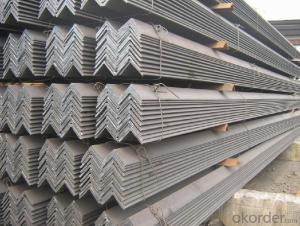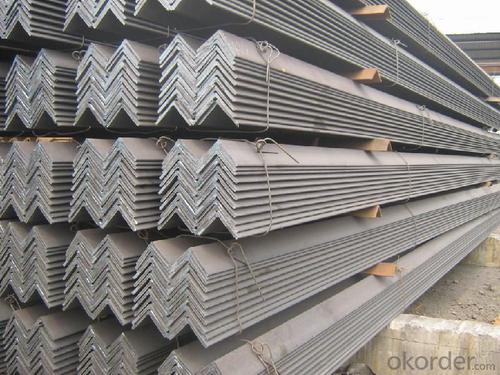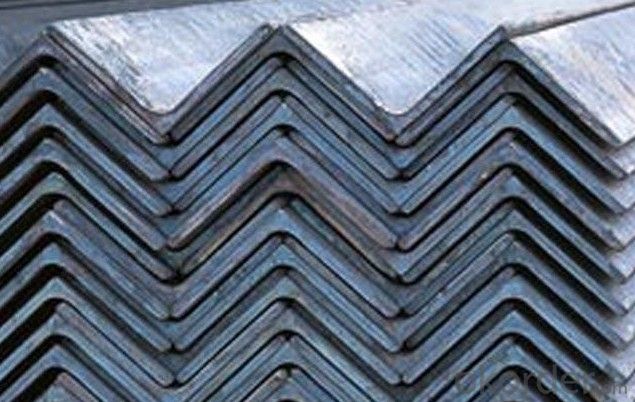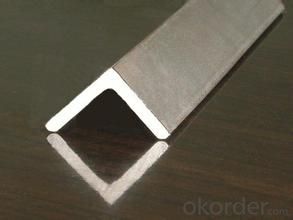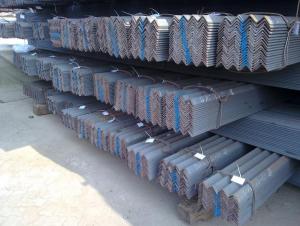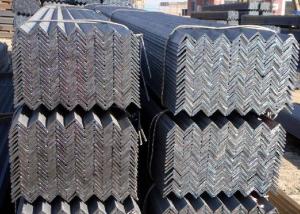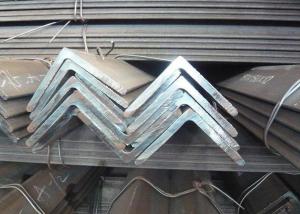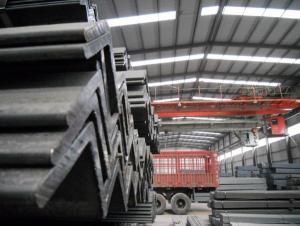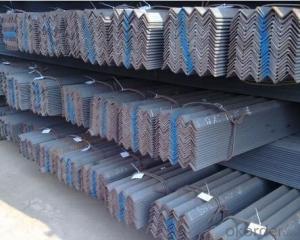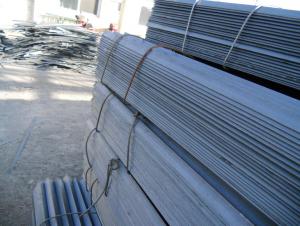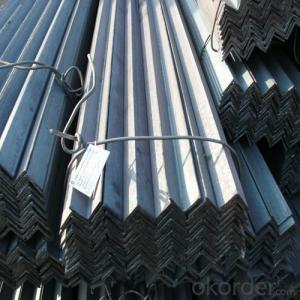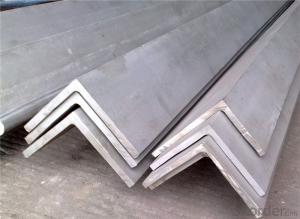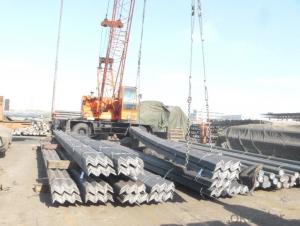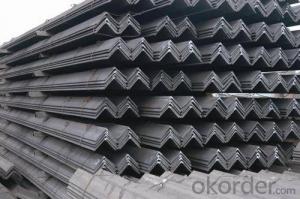The supply of high quality hot rolling angle
- Loading Port:
- Tianjin
- Payment Terms:
- TT OR LC
- Min Order Qty:
- 300 m.t.
- Supply Capability:
- 5000 m.t./month
OKorder Service Pledge
OKorder Financial Service
You Might Also Like
The [ji o g editor last angle have a ng]
Angle called angle, strip steel is perpendicular to each other on both sides into angular. There are equilateral angle steel and unequal angle of. Equilateral angle steel two edge width equal. The specification is expressed by edge widthx edge width * thick edge millimeter number. Such as "front 30 x 30 x 3",namely said equilateral angle steel edge width of 30 mm, 3 mm thick edge.Also available models represent models is the edge width, number of centimeters, such as angle 3#. Models of the same model that in the differentedge thickness and size, and thus in the contract documents generalboundary angle width, edge thick size fill in complete, avoid use alone model said. Hot rolled equilateral angle steel specifications for 2#-20#. Angleaccording to the different needs of structure composed of a variety of stress components, but also can be used as a component of the connections between the. Widely used in a variety of architectural and engineering structures, such as beams, bridge, tower, lifting the transport machinery, ships,industrial furnace, reaction tower, container frame and warehouse.
Chinese name angle
Which is called angle
The outer shape perpendicular to each other on both sides into strip steelangle
Classification of equilateral angle steel and equilateral angle steel
The material of carbon structural steel
The raw materials of low carbon square billet billet
Catalog
The 1 angle is introduced
2 types of specifications
3 import and export
4 appearance quality
5 chemical composition
6 specifications
7 mechanical properties
8 weight calculation
9 theoretical weight
The 1 angle is introduced
Edit
Angle according to the different needs of structure composed of a variety of stress components, but also can be used as a component of the connections between the. Widely used
In a variety of architectural and engineering structures, such as beams, bridge,tower, lifting the transport machinery, ships, industrial furnace, reaction tower,container rack, cable channel support, power piping, bus mounting bracket,and warehouse shelves.
Angle is built with carbon structural steel, is a simple section steel steel, mainly used for metal components and the frame of the plant. In use requires a goodweldability, plastic deformation and certain mechanical strength. The production of raw materials for low carbon steel billet steel billets, finished angle for the hot rolling, normalizing or hot-rolled state of delivery.
2 types of specifications
Edit
Mainly divided into equilateral angle steel and equilateral angle steel two kinds,including unequal angle can be divided into equilateral equilateral thick andunequal thickness two.
Angle specifications expressed with side length and edge thickness size. At present domestic steel specifications for 2 - 20 cm in length, number number,the same horn steel often have 2 - 7 different edge thickness. The actual size and edge inlet angle marked on both sides of the thickness and indicate the relevant standards. The general length of more than 12.5cm for large angle,12.5cm - 5cm for the medium angle, length below 5cm for small angle.
Inlet and outlet angle steel orders generally required the use specifications in the main, the steel is carbon steel grades corresponding. Is the angle in addition to standard number, no specific composition and performance series.
Equilateral angle vector
Angle iron delivery length is divided into fixed length, double length two,domestic angle of fixed length of choice scope has 3 9m, 4 12M, 4 19m, 6 19mfour scope according to the specifications of different. Japanese angle length selection range is 6 - 15m.
Section unequal angle height according to the long edge of the width to calculate the scalene angle steel. Refer to section for angular and both sidesunequal in length of steel. Is an angle of. Its length from 25mm * 16mm to200mm * l25mm. From the hot rolling mill and rolling. General specifications for: scalene angle steel angle 50*32-- angle 200*125 thickness of 4-18mm
Unequal angle steel is widely used in all kinds of metal structures, bridges,machinery manufacturing and shipbuilding, building structure and engineering structures, such as beams, bridges, power transmission tower, lifting the transport machinery, ships, industrial furnace, reaction tower, container frame and warehouse etc.
3 import and export
Edit
China's import and export have a certain angle each batch, mainly imported from Japan and Western europe. Exports to Hong Kong and Macao, Southeast Asia, the area is mainly on Latin America and Arabia countries etc.. Export production enterprises mainly in Liaoning, Hebei, Beijing, Shanghai, Tianjin and other provinces and cities of iron and steel plant (rolling mill).
Angle for the large variety of imports, small angle and special shape angle,export varieties for the medium angle such as 6, 7, etc..
4 appearance quality
Edit
Angle of the surface quality of the standard provisions, may not exist generally require the use of harmful defects such as delamination, cracks, scarring, etc..
Angle geometry to allow the range of the standard deviation is also provided,generally include curvature, edge width, the edge thickness, dip angle and theoretical weight etc., and provides a significant angle not reverse.
5 chemical composition
Edit
(1) composition indexes: the chemical composition of angle steel rolling steel series with the general structure, the main validation indicators C, Mn, P, Sfour. According to the different brands and content varies, generally is in the range of C<0.22%, Mn:0.30 - 0.65%, P<0.060%, S<0.060%.
(2) test method: detect the chemical composition, method for the inspection ofcommon standards GB223, JISG1211 - 1215, BS1837, BS 19, t is the technicalmanual 22536 etc..
6 specifications
Edit
Angle steel
GB/T2101 - 89 (general provisions steel acceptance, package, mark andquality certificate); GB9787 - 88/GB9788 - 88 (steel equal / unequal angle steel dimensions, shape, weight and permissible deviations); JISG3192 94(shape, size, hot rolled steel and weight tolerance); DIN17100 80 (qualitystandard steel common structure); gamma is C 535 - 88 (technical conditions of ordinary carbon steel).
According to the provisions of these standards, angle should be a bundle of delivery, the strapping lane, the same bunch length should be specified. Angle is generally within the bare delivery, transport and storage are need to note。
- Q: How do steel angles perform in high-humidity environments?
- Steel angles perform well in high-humidity environments due to their corrosion-resistant properties. The presence of moisture in the air can often lead to rust and corrosion of metals, but steel angles are designed to withstand these conditions. They are typically made from stainless steel or galvanized steel, both of which have a protective layer that prevents rust formation. This makes them highly suitable for use in areas with high humidity, such as coastal regions or industrial settings where moisture is prevalent. Additionally, steel angles are durable and have a long lifespan, further enhancing their performance in high-humidity environments.
- Q: How do you calculate the buckling strength of a steel angle?
- Several factors must be taken into account in order to calculate the buckling strength of a steel angle. The buckling strength refers to the angle's ability to withstand buckling or collapse under applied loads. To begin, the geometry of the steel angle must be established. This involves determining the angle's dimensions, including the length of the legs and the thickness of the steel. Additionally, the cross-sectional properties, such as the moment of inertia and section modulus, need to be computed. Following that, the effective length of the angle needs to be determined. The effective length measures the angle's level of restraint against buckling. It depends on factors such as the boundary conditions and connection details. The effective length can differ for various modes of buckling, such as flexural or torsional buckling. Once the effective length is known, the critical buckling load can be calculated using an appropriate buckling equation. Various buckling equations are available, depending on the boundary conditions and mode of buckling. For example, the Euler buckling equation can be used for long, slender angles subjected to axial compression. Other equations, such as the Johnson buckling equation, may be employed for more complex loading scenarios. The critical buckling load can then be converted to an allowable stress using a suitable safety factor. The safety factor accounts for uncertainties in the calculation and ensures that the angle can safely bear the applied load without buckling. Design codes or industry standards typically specify the safety factor. In conclusion, calculating the buckling strength of a steel angle involves determining its geometry and effective length, applying an appropriate buckling equation, and converting the critical load to an allowable stress using a safety factor. It is essential to consult relevant design codes and standards to ensure accurate and safe calculations.
- Q: What's the size of No. 5 angle iron?
- Angle called angle, the steel strip is perpendicular to each other on both sides into the corner. There are equal angles and unequal angles. The two sides of an equal angle steel are equal in width.
- Q: How do steel angles perform in terms of water resistance or waterproofing?
- Steel angles typically do not have inherent water resistance or waterproofing properties. Since steel is a metal, it is susceptible to corrosion and rust when exposed to water or moisture for extended periods of time. However, the water resistance or waterproofing of steel angles can be improved through various measures. One common method is to apply a protective coating, such as galvanizing or painting, to the steel angles. Galvanizing involves coating the steel with a layer of zinc, which acts as a barrier against water and prevents corrosion. Painting, on the other hand, creates a protective layer that helps to seal out moisture and prevent direct contact between the steel and water. Additionally, proper design and installation techniques can also enhance the water resistance of steel angles. For example, ensuring proper drainage and avoiding water accumulation on or around the steel angles can prevent long-term exposure to moisture, reducing the risk of corrosion. It is important to note that even with these measures, steel angles may still be susceptible to water damage if the protective coatings become compromised or if there is constant exposure to harsh environmental conditions. Regular inspection, maintenance, and prompt repair or recoating of the steel angles are essential to ensure long-lasting water resistance.
- Q: What does 50*50*5 angle mean?
- 50*50*5 angle means: the outer section of angle steel is 50mmx50mm, and the angle steel is 5mm.
- Q: What are the typical uses for steel angles?
- Steel angles are commonly used in construction and manufacturing industries for various purposes such as providing structural support, reinforcing corners and edges, framing buildings, creating shelves and brackets, and fabricating machinery and equipment.
- Q: How are steel angles protected against atmospheric corrosion?
- There are various methods available to protect steel angles from atmospheric corrosion. One commonly used method is the application of a protective coating, such as paint, on the surface of the steel angles. This coating acts as a barrier, preventing direct contact between the steel and moisture or oxygen, which are the main causes of corrosion. Another method of protection is galvanization. Galvanization involves coating the steel angles with a layer of zinc, either through hot-dip galvanization or electroplating. The zinc acts as a sacrificial layer, corroding instead of the steel. This sacrificial corrosion process helps safeguard the steel angles from atmospheric corrosion. Apart from coatings, inhibitors can also be used to protect steel angles. Inhibitors are substances that can be added to the environment or applied directly to the steel surface to slow down or prevent corrosion. These inhibitors work by forming a protective film on the steel surface or by altering the chemical environment to reduce corrosion. Regular maintenance and inspection are crucial in protecting steel angles against atmospheric corrosion. This includes cleaning the surface of the steel angles to remove any dirt or debris that can trap moisture and speed up corrosion. It is also important to promptly repair any damaged or deteriorated coatings to ensure continuous protection against corrosion. In conclusion, a combination of protective coatings, galvanization, inhibitors, and regular maintenance is necessary to effectively shield steel angles from atmospheric corrosion and prolong their lifespan.
- Q: What are the different types of steel angles used in modular furniture?
- Modular furniture commonly utilizes various types of steel angles. These angles, which are typically made from different grades of steel like stainless steel and mild steel, come in different shapes and sizes to accommodate diverse furniture designs and applications. 1. Unequal angles, also referred to as L-shaped angles, are a prevalent choice in modular furniture. They feature one longer leg and one shorter leg, creating a 90-degree angle. These angles are commonly employed to enhance the structural support and stability of furniture components such as table legs or shelf brackets. 2. Square angles, also known as equal angles, possess two legs of equal length that meet at a 90-degree angle. They are frequently used in furniture frames to provide durability and strength to the structure. The versatility of equal angles allows for various applications, including the creation of corners and joints. 3. Triangular angles, or V-shaped angles, contribute decorative accents and design elements to modular furniture. These angles consist of two legs that converge at a point, forming a V shape. They are often utilized to add visual interest to furniture pieces like chair backs or table bases. 4. Although not technically classified as angles, flat bars are commonly employed in modular furniture construction. These elongated, rectangular-shaped steel bars possess a flat surface and can be used to reinforce furniture frames or create structural elements such as crossbars or supports. 5. Perforated angles, featuring holes or slots along their length, are ideal for adjustable shelving systems. These angles allow for easy installation and adjustment of shelves at different heights, providing flexibility in organizing and customizing modular furniture. It is important to note that the specific type of steel angle used in modular furniture can vary depending on factors such as desired strength, aesthetics, and functionality of the furniture piece. Different manufacturers and designers may have their own preferences and specifications when selecting steel angles for their modular furniture designs.
- Q: What is the cost of steel angles?
- The cost of steel angles can vary depending on factors such as the size, thickness, and quality of the steel, as well as market conditions and supplier pricing. It is best to contact a steel supplier or check online platforms to get specific pricing information for the desired steel angles.
- Q: What are the different types of steel angles used in automotive engineering?
- There are several types of steel angles used in automotive engineering, including equal angles, unequal angles, and L-shaped angles. These angles are commonly used for structural support, reinforcement, and to provide strength and stability to various components of the vehicle.
Send your message to us
The supply of high quality hot rolling angle
- Loading Port:
- Tianjin
- Payment Terms:
- TT OR LC
- Min Order Qty:
- 300 m.t.
- Supply Capability:
- 5000 m.t./month
OKorder Service Pledge
OKorder Financial Service
Similar products
Hot products
Hot Searches
Related keywords
